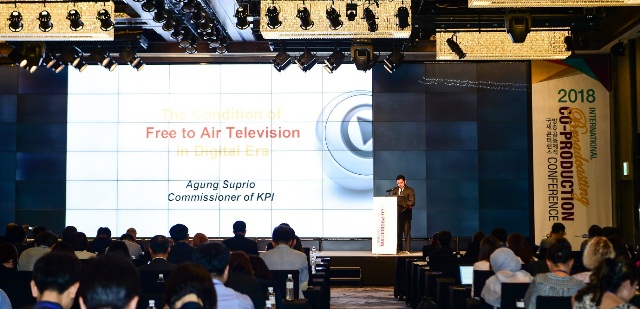- Detail
- Ditulis oleh RG
- Dilihat: 58043

The Condition of Free to Air Television in Digital Era
By: Agung Suprio
Commissioner at Indonesian Broadcasting Commission
Presented in a broadcasting conference at South Korea, 28th June 2018
I would like to share brief information about the condition of Free to Air television in the digital era. Beforehand, I will explain the responsibilities of Komisi Penyiaran Indonesia (KPI) or Indonesian Broadcasting Commission.
The Responsibility of KPI and Free to Air Television
Indonesia Broadcasting Commission (KPI) is an independent state institution that aims to guarantee information delivery to society, to grow broadcasting industries in Indonesia, and to create qualified broadcasting based on nation ideology.
KPI was established under the Broadcasting Law in 2002. At that moment, the condition of information technology and the broadcasting system was quite different compared to the present days where the system was still analog.
KPI is based on two principles, ownership diversification and content diversification. Ownership Diversification is aimed to avoid the monopoly in public frequency by certain parties. Content Diversification is aimed to create diverse content for society, such as educational, cultural, and women and children content.
National-private television in Indonesia known as giant broadcasters that have a bigger income, asset and capital also have a wide area of broadcasting to gain more viewers and advertisers than local-private television. At present, there are 700 Free to Air televisions, consist of public television, national-private television (known as networked television), and local-private television. National- private television is responsible to broadcast local content in each province at least 10 % of overall content every day.
Besides national-private and local-private television, pay-television also has a potential market in Indonesia. The number of the customer is predicted to be increasing each year, recorded around 4 million customers at present, since internet-based broadcasting, such as Over the Top, has also increased.
KPI expects the content of television can match with Indonesian values, especially on free-to-air television, so that it can broadcast high-quality local content. At this moment, one of national-private television holds a Dangdut (authentic Indonesian song genre) singing competition. It's participants not only from Indonesia but also from other Asian countries. Respond to this, KPI appreciates and encourages local content to be a leader in Indonesian content which gaining viewers from other countries.
Broadcasting Trend
Nowadays, internet-based broadcasting can be enjoyed by most people because of the development of internet infrastructure in the majority of the Indonesia area. Almost 250 million Indonesians have a smartphone and connected to the internet. Therefore, they prefer to access information through new media such as YouTube, facebook, twitter, WhatsApp, which are able to be accessed anytime and anywhere, as long as there is an internet connection. It affects the decreasing of conventional television viewers while the new media gets more viewers.
However, KPI optimists the presence of new media since it triggers the appearance of creative industries that create local content to be watched by a global citizen. The trend also made owners of national-private television deliver its content from free-to-air to the new media, such as YouTube or streaming platforms, so they also can gain more advertisements.
Since 2015, the conventional television industry has penetrated digital television. Digital television that broadcasts over-the-top content is also increasingly enjoyed by the public, especially in big cities. The duration of over-the-top content has also increased to rival the duration of content on free-to-air and pay-TV. The tendency of people to access the new media as entertainment has increasingly benefited the position of the new media itself. Is this a signal of the loss of conventional media, especially free-to-air television in Indonesia?
We may see this competition in a positive way. It can enhance the content creators to produce more qualified local content. Foreign programs, especially Hollywood movies, on free-to-air TV had confirmed that its viewers were decreased because that kind of program can be repeatedly watched through new media. Eventually, the national content will dominate again in every form of media and bring more advertisers and more income.
Therefore, KPI supports the effort of KCC to do co-production with other Asian countries, including Indonesia, in order to create content which is able to introduce Asian values on conventional television or new media.
Closing: The New Regulation?
Indonesia has not to do broadcasting migration from analog to digital yet, because the draft bill has not passed the parliament. KPI optimists that the bill can be enacted this year because Indonesia has agreed in the ITU forum to do analog switch-off in 2020. The new broadcasting constitution will give legitimacy for the presence of new media and manage it based on the principles of a democratic country.
The migration will make all of Indonesia's areas connected with a fast internet connection. It will become more competitive between free-to-air television with internet-based broadcasting. Free-to-air television can do convergence while internet-based broadcasting can also be viewed through hybrid-mode television which the price will be cheaper in the upcoming year.
Finally, KPI would like to say thank you for the invitation to this forum. Through this forum, KPI can give information about the broadcasting in Indonesia and learn as much as possible from other countries, which have been doing such migration, in order to manage the competition among any form of media.









